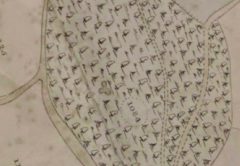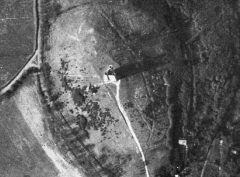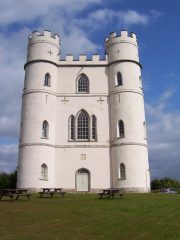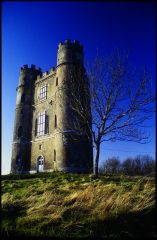Haldon Belvedere (MDV9418), also known as Lawrence Castle, is a memorial tower dating back to the late 18th century. It was erected, during a major landscaping of the area, in 1787, by the Palk family, who Hoskins records living at Haldon until 1892. The belvedere commemorates and celebrates their friend Major-General Stringer Lawrence, commander of the British Army in India, who died in 1775. The Grade II listed building is located to the west of Exeter in the civil parish of Dunchideock. It is situated in a solitary position upon a knoll, 244 metres above sea level, boasting beautiful panoramic views in all directions.

But the Palks were not the first to settle on the high ground on which the belvedere stands. Occupation by Neolithic people approximately 4200 to 6000 years ago was discovered during archaeological excavations in the 1930s. A rectangular stone-walled hut, hearths, a stone-lined chamber and cairn were recorded, as well as numerous flint tools and pottery similar to that found at Hembury. Later investigations in 1994-95, undertaken by C. and N. Hollinrake and Exeter Archaeology, revealed further use during the early Neolithic period. Finds included a large artefact scatter, including fragments of local Gabbroic and Granitic pottery, and over a thousand flint and chert stone tools, consisting of broken leaf-shaped arrowheads, blades, scrapers, awls, cores, and various other flakes. Some flints showed evidence of burning, and the presence of an asymmetric arrowhead suggests settlement activity into the late Neolithic period. Large numbers of flint tools (e.g. MDV46806 & MDV14734) have been found in the wider area, again pointing to the importance of the ridge in this period.

Evidence suggests that the ridge continued to be occupied into the later prehistoric period, and burial mounds have been recorded in this area, along with a number of Roman coins including those of emperors Victorinus and Gallienus. Scientific dating of ‘avena’ oats excavated from the lower fills of a pit produced a much later radiocarbon date of cal AD 595-690, indicating use into the early Medieval period. During the Civil War the hills at Haldon may have served as a natural barrier preventing easy movement of troops.
The belvedere had previously been accompanied by what was known as ‘Haldon House’. This early 18th century building, thought by Pevsner to be modelled on the style of Buckingham Palace, sat below the ridge within 11,000 acres of park and gardens, and had been extravagantly decorated by previous owners, the Clifford family. In time the house and its lands were sold, and ultimately demolished in the 1920s. The belvedere was also sold, and remained privately owned until 1994 when it was passed on to the Stringer Lawrence Memorial Trust.


By this stage, the structure was in such a poor state that it was uninhabitable. However, in the 1990s the Devon Historic Buildings Trust undertook restoration of the three-storey tower including reinstating its ornate rendered stone rubble plasterwork, gothic style windows and doors, stone cantilevered spiral staircase, and mahogany flooring. In 2016 further restoration of the exterior included the complete redecoration of the walls, paintwork, and windows.
Today the belvedere is used is for events such as weddings, and private hire. However, the grounds are open and free to use at any time and visitor information can be found here.
Hoskins, W. G. 1954 A New Survey of England: Devon. Collins: London
Cherry, B. & Pevsner, N. 1989 The Buildings of England: Devon. Penguin: London